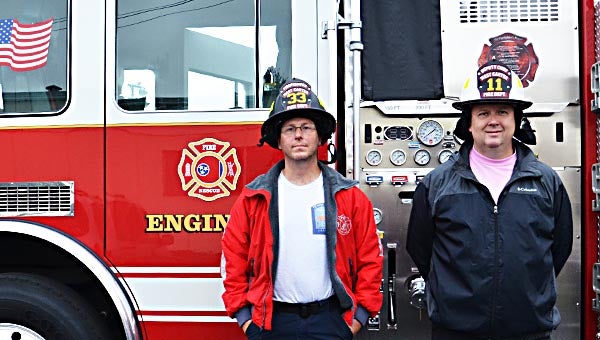County volunteer fire departments facing staffing issues
Published 8:48 am Monday, October 19, 2015

Star Photo/Rebekah Price Landon Humphreys and David Howland are firefighters with the West Carter County Volunteer Fire Department.
The numbers of Carter County volunteer firefighters have been on a steady decline over the last 20 years, according to Jason Shaw, president of the Carter County Volunteer Fire Fighters Association.
“It’s a problem everywhere,” said Shaw. “It doesn’t seem folks have the time or willingness to do what we do.”
Shaw is a firefighter with the Stoney Creek VFD, where he said they have 27 members listed as active staff, but that only a core group of five to 10 members from one station are on-site in emergencies, if they are lucky.
Shaw said that 10-20 years ago, this would have been about 15-20 firefighters.
The problem is not unique to Stoney Creek’s department.
“That’s the biggest issue we’re facing right now–staffing,” said David Howland of the West Carter VFD.
Shaw believes a reason for the decline is that people are working so much, often at two or three jobs, or attending school and don’t have the time to train or respond. He said it is possible that they have not recruited enough.
“This is a state and national issue,” he said.
It is also possible that some people move from urban areas into the county and do not realize what it takes to operate a volunteer department, Shaw said..
“I think Carter County is truly blessed to have the folks we have,” said Carter County Emergency Management Agency Director Gary Smith. “They work regular jobs and can get paged out on a fire at 2:30 a.m. and then show up at 8 a.m. for work.”
Smith said he thinks two misconceptions that people have are that these firefighters get paid and that their stations are staffed at all hours of the day. With so few able to make the time commitment, they cannot always staff the stations.
“It would be ideal to have someone there all the time,” said Shaw.
With more emergency responders, response time could be faster, thereby preventing more damage to homes and saving more lives, Shaw said.
Smith said it is possible that the community does realize see the value of the volunteer fire departments.
In 2014, firefighters in Hampton, Stoney Creek and Watauga responded to 97 fires and saved an estimated property value of $1,018,400. At these three stations, total hours worked were 8,240.
Each firefighter has a radio and drives from home or wherever they are to the fire station to suit up, and then to the scene of the fire. Anytime a call goes out, the two closest stations are also called to assist.
Shaw said that when he started, that call went out to other stations to bring water, but now it brings manpower also.
“We work with each other now more than ever,” said Shaw.
With an increased number of non-emergency response volunteers, Shaw said they could accomplish things like implementing a junior firefighter program to allow high school students the opportunity to learn about operations at the station. The Hampton VFD has one such program. Another potential opportunity for station volunteers would be membership in the Fire Core Program, a national community assistance group for local volunteer fire departments.
“There’s a lot that goes on behind the scenes that people can help with,” said Smith.
Shaw said that at the Stoney Creek station, they burn wood for heat, so it must be supplied and chopped. Trucks must be washed and started. Equipment must be checked routinely.
“If they don’t want to respond to emergencies, they could help with maintaining the station, educating the community about fire safety, and installing smoke alarms with the state Fire Marshall’s Get Alarmed program,” said Shaw.
Staffing is not the only issue departments are facing. They must come up with a large portion of their budgets through fundraisers and donations.
“We ask volunteer firefighters to spend more time fundraising then they are required to spend in training,” said Shaw.
The annual budget for all seven departments is $711,108–approximately $45,000 per department. The county pays $315,000, and departments are left to come up with the difference. They accomplish this primarily by selling fireworks for the Fourth of July but hold other fundraisers as well.
“Any support that the community can provide is value back to that community,” said Smith. “We have an incredibly dedicated group, and there will be response, but they could certainly use more help.”
For information on how to get involved, people should contact their local volunteer fire departments.
Other than encouraging the community to donate time and money, Smith and Shaw wanted to remind everyone to check smoke alarms as well as furnaces which may have been covered or near furniture through the summer.




